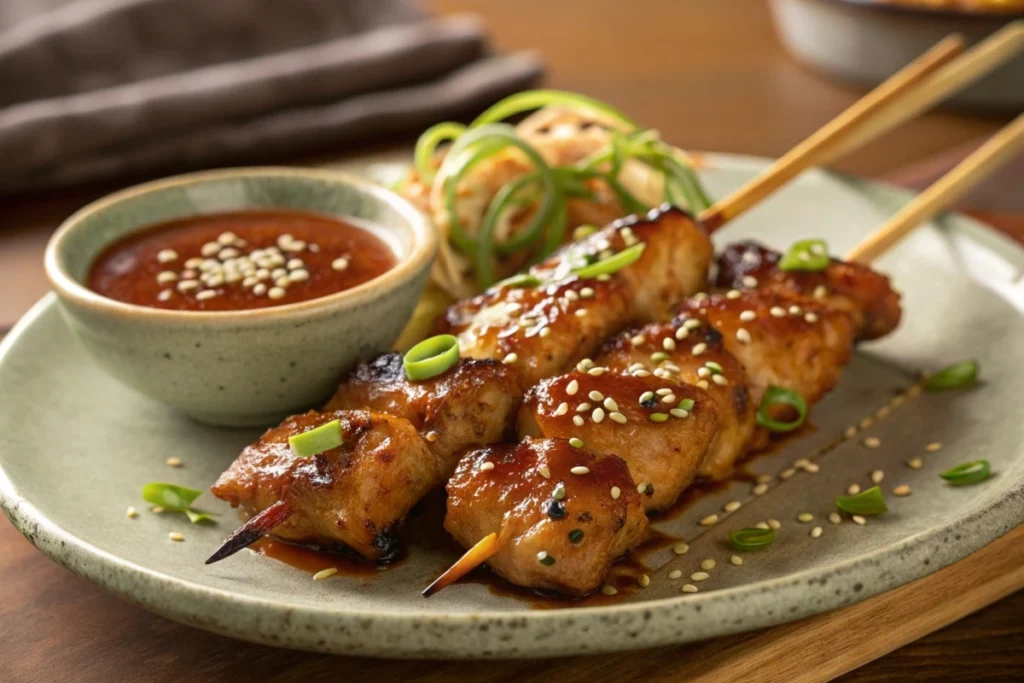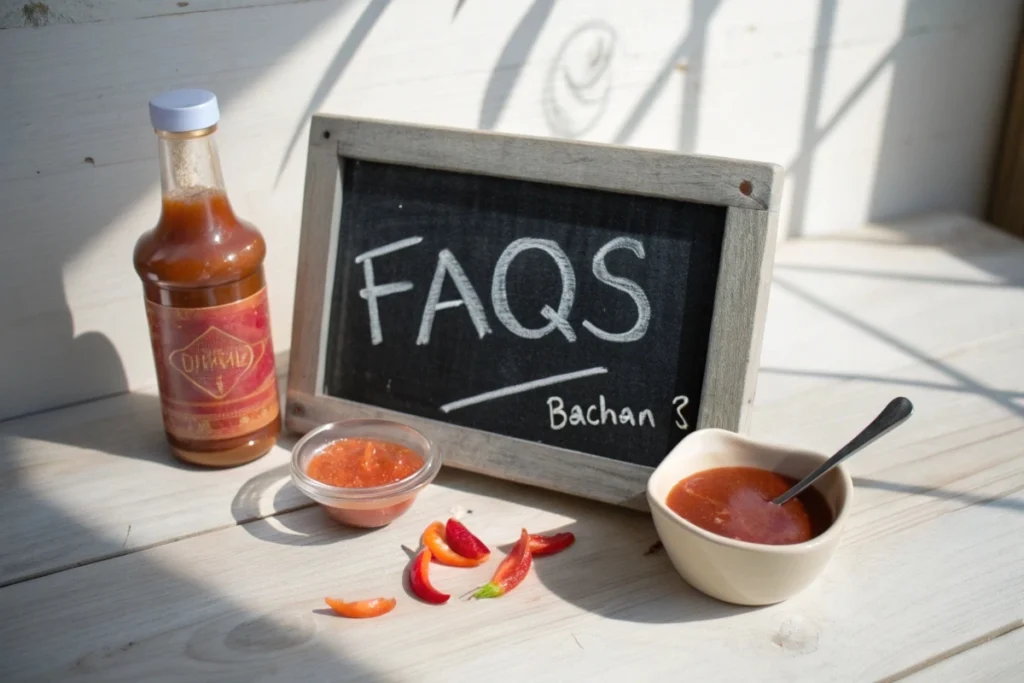When you think of bachans japanese sauce recipes, imagine a versatile, umami-packed condiment that can transform ordinary meals into unforgettable experiences. Within the first 100 words, let’s highlight the primary keyword. Bachans japanese sauce recipes have gained popularity worldwide for their rich, balanced flavors and adaptability to various dishes. Whether you’re new to Japanese cuisine or a seasoned home cook, this sauce can guide you through creating authentic, restaurant-quality meals at home.
Wondering how to use japanese bbq sauce beyond grilling? Bachan’s sauce can be a marinade, a glaze, or a finishing touch. Its unique blend of soy, sweeteners, and spices brings depth to chicken, beef, tofu, and vegetables. If you’re curious, you can pair it with a traditional Japanese desserts recipe to create a balanced dinner menu that ends on a sweet note.
In this article, we’ll explore the history, flavors, and best ways to use Bachan’s Japanese sauce. We’ll discuss whether does barbecue sauce have gluten, and how to adapt recipes for all dietary needs. By the end, you’ll confidently whip up japanese bbq sauce chicken recipe dishes and discover how this sauce can elevate your dinner table.

Must-Have: To try these recipes authentically, I recommend keeping a bottle of Bachan’s Japanese BBQ Sauce in your pantry. It’s versatile, flavorful, and the star of all the dishes below.
Main Sections
1. Understanding Bachan’s Japanese Sauce
Bachans japanese sauce recipes revolve around a sauce that’s inspired by traditional Japanese barbecue flavors. Bachan’s sauce typically features soy sauce, garlic, ginger, sugar or mirin for sweetness, and a balanced umami profile. Unlike American barbecue sauces, which can be thick and smoky, Bachan’s sauce is lighter and more versatile. It can glaze grilled meats, marinate chicken, or serve as a finishing drizzle for stir-fries.
How to use japanese bbq sauce? Start simple: brush it over grilled chicken, beef, or seafood for a glossy finish. Or use it as a dipping sauce for dumplings and spring rolls. This adaptability sets it apart, making it a staple in Japanese-inspired kitchens. For even more culinary inspiration, consider pairing it with japanese chicken fried rice recipe to bring extra depth to your meal.
When you explore japanese bbq sauce chicken recipe variations, remember that marinating helps the sauce infuse into the meat. Can you use bachan’s as a marinade? Absolutely. Let chicken thighs soak in it before grilling or pan-frying, and you’ll get tender, flavorful results. If you’re curious about plant-based options, add a splash of this sauce to vegan japanese recipes to enhance umami without relying on animal products.
Gluten-Free Option: If you’re sensitive to gluten, you can try Tamari Gluten-Free Soy Sauce. It offers the same deep umami flavor without wheat.
Another question that arises: Does Bachan’s need to be refrigerated? Most store-bought versions recommend refrigeration after opening to maintain freshness. Always check the label. Speaking of dietary concerns, does barbecue sauce have gluten? Many Japanese BBQ sauces use soy sauce, which may contain wheat. However, gluten-free versions exist. Look for “gluten-free” on the label or opt for tamari-based sauces to accommodate dietary needs.
Overall, understanding Bachan’s sauce means recognizing its roots in Japanese culinary tradition. It’s a sauce that emphasizes balance—sweet, savory, salty—rather than overpowering flavors. With its ability to complement vegetables, tofu, seafood, and meat, it’s an essential tool in your kitchen arsenal.

2. Cooking Techniques and Ingredient Pairings
For bachans japanese sauce recipes, mastering cooking techniques is key. Whether you’re grilling, pan-searing, or roasting, adding Bachan’s sauce at the right time ensures optimal flavor and texture. For chicken, consider the japanese bbq sauce chicken recipe approach: marinate the chicken for at least 30 minutes, then grill over medium heat. Brush more sauce as it cooks for a caramelized finish.
Kitchen Tool Tip: Raping fresh ginger makes all the difference. A tool like the Kyocera Ceramic Ginger Grater helps extract juice and flavor easily.
How to use japanese bbq sauce in stir-fries? Sauté your protein and vegetables in oil first, then add the sauce near the end to prevent burning. Bachan’s sauce can also top steamed vegetables, lending them a savory gloss that pairs well with vegetables japanese recipe side dishes.
If you’re feeling adventurous, try making a homemade japanese bbq sauce inspired by Bachan’s flavors. Combine soy sauce, mirin, brown sugar, ginger, garlic, and a hint of chili for heat. Adjust sweetness and saltiness to taste. Once you perfect your blend, use it as a marinade for tofu steaks or brush it onto grilled eggplant for a vegetarian feast.
Seafood lovers can glaze salmon fillets with Bachan’s sauce before broiling. Serve alongside noodles-japanese-pan-noodles-recipe to create a satisfying dinner. For those who enjoy beef, pair marinated steak strips with a side of steak-japanese-recipe inspired sides and a bowl of steamed rice.
In essence, Bachan’s sauce works harmoniously with a variety of ingredients:
- Meats: Chicken, beef, pork, seafood.
- Vegetables: Bell peppers, broccoli, bok choy, mushrooms.
- Carbohydrates: Rice, noodles, and even mashed potatoes for a fusion twist.
Prep Hack: For marinating chicken or beef, I love using Glass Marinating Containers and a Silicone Basting Brush. They make cleanup simple and keep flavors consistent.
Experiment with portion sizes and cooking times. Keep in mind the sauce’s balance of sweet and savory. For a tangier flavor, add a splash of rice vinegar. To enhance umami, include a teaspoon of miso paste. Remember, the goal is not to mask flavors but to complement them. Through practice, you’ll develop a personal approach to using Bachan’s sauce in creative ways.

3. History/Context
Bachan’s sauce may feel like a modern sensation, but its roots lie in the rich history of Japanese culinary tradition. Japanese barbecue sauces draw inspiration from centuries of cooking techniques. The word “Bachan” often refers to a grandmother or elder in Japanese culture. A grandmother’s kitchen is where many secret recipes originate. These sauces reflect family traditions, passed down and adapted to modern palates.
Before the advent of commercial sauces, home cooks combined soy sauce, mirin, and sugar for savory-sweet glazes. Over time, influences from global cuisines—such as American barbecue—led to hybrid sauces that retain Japanese identity. Bachan’s, a brand that has gained traction, epitomizes this evolution. It pays homage to Japanese home cooking while catering to contemporary tastes.
In post-war Japan, the influx of foreign cuisines and ingredients sparked culinary creativity. Homemade japanese bbq sauce recipes emerged, melding local flavor profiles with barbecue techniques learned from abroad. As Japan’s economy flourished, so did its culinary diversity. Eventually, Japanese barbecue-style sauces found their way onto grocery shelves worldwide.
Regional variations add depth. Some places favor sweeter profiles, while others embrace spice. Yet the core elements remain: soy sauce for umami, sweeteners for balance, and ginger or garlic for aromatic depth. Today, Bachan’s sauce stands as a bridge between tradition and innovation. It encourages home cooks to experiment, whether they’re creating a japanese barbecue sauce chicken marinade for a family dinner or customizing it for vegetarian meals.
This historical context explains why bachans japanese sauce recipes resonate with people globally. They embody a culinary legacy that values harmony, authenticity, and adaptation. As you enjoy these sauces, remember you’re partaking in a tradition that transcends borders. Pairing Bachan’s sauce with mashed-japanese-sweet-potato-recipe or finishing a meal with authentic-japanese-barbecue-sauce-chicken-recipe-easy-delicious ties you to a story that began generations ago and continues evolving today.

4. Practical Examples/Use Cases
Consider a weeknight dinner scenario. You have chicken thighs and a bottle of Bachan’s sauce. Can you use bachan’s as a marinade? Yes. Marinate the chicken for an hour, then grill or pan-fry until the skin turns crispy. Brush on extra sauce, serve with steamed rice and sautéed vegetables, and you’ve created a japanese bbq sauce chicken recipe that’s both simple and restaurant-worthy.
For vegetarians, marinate tofu or tempeh in Bachan’s sauce, then pan-sear until caramelized. Serve over japanese-chicken-fried-rice-recipe—or try a vegan adaptation with vegan-japanese-recipes—to enjoy a savory, satisfying meal without meat.
Another idea: drizzle Bachan’s sauce over roasted vegetables or use it as a finishing sauce for noodles. If you love experimenting, try a side-by-side tasting: brush half your grilled shrimp with Bachan’s sauce and the other half with a basic teriyaki. Notice how Bachan’s offers a more nuanced, balanced flavor that complements rather than overwhelms.
For a fun appetizer, glaze chicken wings with Bachan’s sauce and serve with pickled ginger. The combination of sweet, savory, and tangy creates a memorable starter. If you’re curious about how to incorporate this sauce into a larger menu, try pairing it with japanese-corn-recipe for a sweet and savory side dish.
Serve it right: For a restaurant-style presentation, try using Japanese Ceramic Ramen Bowls. They’re perfect for rice, noodles, or glazed salmon with Bachan’s sauce.
These examples prove that bachans japanese sauce recipes are not limited to grilling. They’re versatile tools that enhance marinades, dips, glazes, and finishing touches. By exploring different proteins, vegetables, and cooking methods, you’ll uncover endless possibilities for making dinner more exciting.

5. FAQs about bachans japanese sauce recipes
1. Can you use Bachan’s as a marinade?
Yes, Bachan’s sauce makes an excellent marinade. Its blend of soy, sweetness, and spices penetrates meats, tofu, and vegetables. Marinate your chicken or beef for 30 minutes to overnight before cooking to enhance tenderness and flavor.
2. Does Bachan’s need to be refrigerated?
Most store-bought sauces, including Bachan’s, recommend refrigeration after opening. This helps preserve freshness and maintain quality. Always check the label for specific storage instructions.
3. What does Bachan’s sauce taste like?
Bachan’s sauce offers a balanced mix of sweet, savory, and umami notes. It’s reminiscent of teriyaki but with a lighter, more nuanced profile. The flavor is not overly thick or smoky, making it versatile for various dishes, from grilled meats to vegetable stir-fries.
4. Does barbecue sauce have gluten?
Many barbecue sauces, including some Japanese-style versions, use soy sauce containing wheat. Check labels carefully if you need a gluten-free option. Some Bachan’s variants may offer gluten-free versions, relying on tamari instead of regular soy sauce.
5. How to use Japanese BBQ sauce on chicken?
For a japanese bbq sauce chicken recipe, marinate chicken pieces in the sauce, then grill or pan-fry until caramelized. Baste with extra sauce while cooking for a glossy, flavorful finish. Serve with rice and vegetables for a complete meal.
6. Is Bachan’s sauce suitable for vegetarians or vegans?
Bachan’s sauce is typically vegetarian-friendly, but always read the label. For vegans, double-check if any animal-derived ingredients are included. When in doubt, pair with vegan-japanese-recipes to create delicious plant-based meals.
7. How long does an opened bottle last?
Follow the brand’s recommendation. Usually, once opened and refrigerated, it can last a few weeks to a couple of months. The sauce’s soy base helps preserve it, but using it sooner ensures optimal flavor.

Conclusion
Bachans japanese sauce recipes open the door to endless culinary exploration. From marinating meats to enhancing vegetables and tofu, this sauce embodies the heart of Japanese cuisine: balance, depth, and simplicity. By integrating this sauce into your dinners, you’ll discover that it elevates everyday meals into memorable feasts.
Now that you understand how to use japanese bbq sauce, experiment with it in various cooking methods. Try a japanese barbecue sauce chicken marinade, or drizzle it over steamed greens. For more inspiration, discover japanese recipes that pair harmoniously with Bachan’s sauce, broadening your culinary horizons and introducing new flavors to your dinner table.
As you embrace Bachan’s sauce in your cooking routine, remember it’s more than just a condiment—it’s a link to generations of Japanese culinary tradition. It fosters creativity and encourages you to explore new techniques. Whether you’re a beginner or an experienced cook, let Bachan’s guide your journey towards authentic and flavorful Japanese dinners.

Japanese Style Teriyaki Sauce
